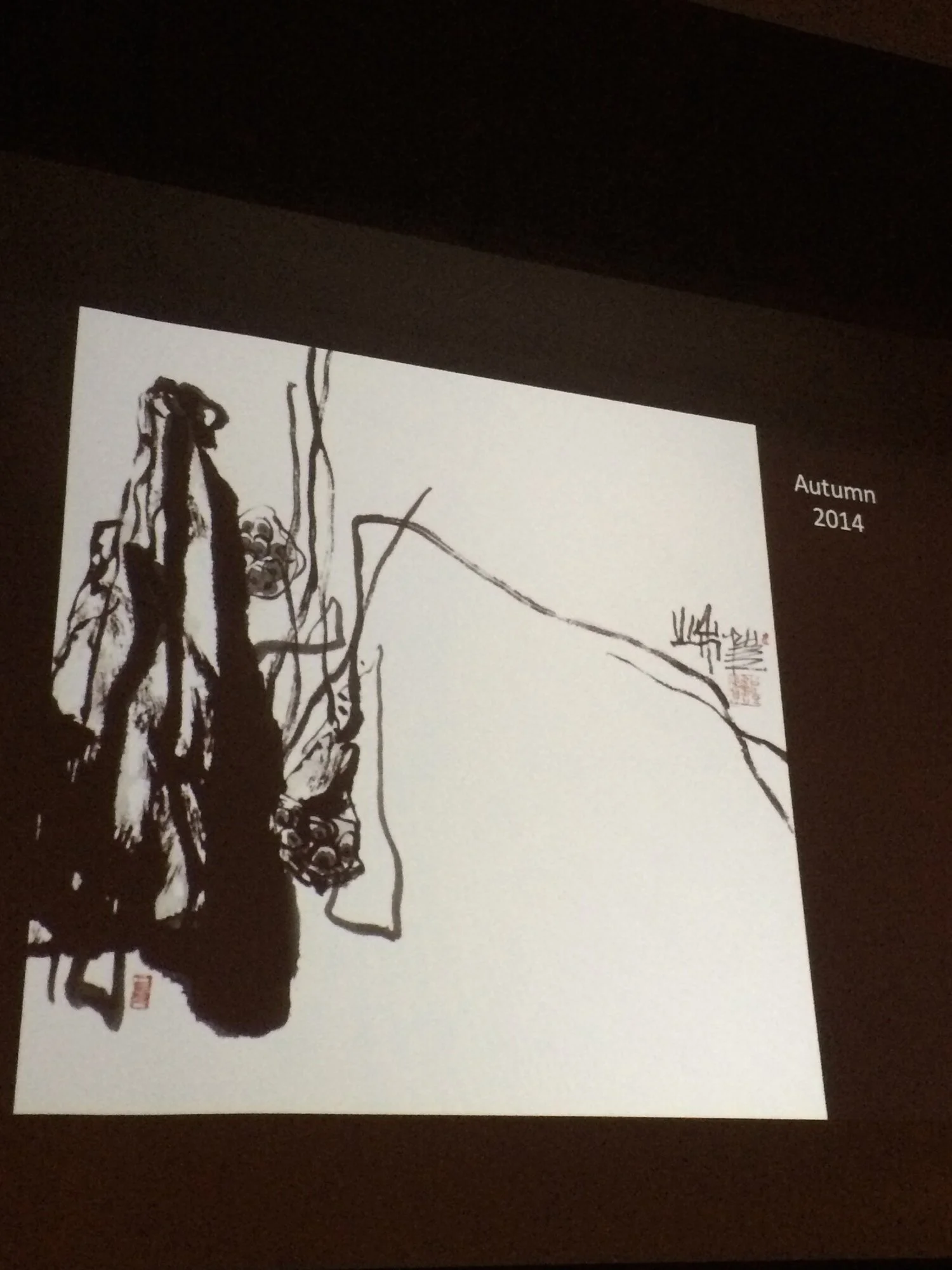Pan Gongkai
One of Gonkai's masterpieces at the Frye Museum in Seattle
Please see Chinese translation of this article, below. Pan Gongkai came towards me and we hugged. It was the third week of September and he was minutes away from retiring from his job as the President of the Central Academy of Fine Arts in Beijing. (China's finest art school.) This did not prevent him from spending time discussing the future of art schools and in particular, the future of the Fine Arts in an era when the Humanities as a whole are being relegated to secondary status in many countries.
Pan Gongkai's work sits at the boundaries of architecture, design, traditional ink painting and a profound concern for the future of art and design education and pedagogy. He is as concerned with contemporary innovations as he is with the history of Chinese art. His work reflects a multi-disciplinary approach, always conscious and deeply aware of the need for craft and for depth in the disciplines he chooses to work in.
Ten days later he was in Seattle where I went to participate in a day-long symposium on his work. The symposium was organized by Jo-Anne Birnie Danzker, the Director of the Frye Museum in Seattle. The day was wonderful as scholars and practitioners talked about Pan Gongkai's work in reverential words, justifiably, because he is not only a major artist in China but such an important contributor to the art scene internationally.
During the course of the day, I came up with five descriptive categories that in a quite personal way, explains the art that Pan Gongkai creates: The time of preparation/research; The time of making; The time of viewing; The time of reflection; The time of memory.
Pan Gongkai
These five elements speak to the intense self-consciousness of Pan Gonkai's approach. He deals with the intersections of time (scrolls) and viewer position. He invokes memory, while also drafting an approach to history. His work is self-conscious without being pedantic. It was this point, made by Professor Joseph Tanke which resonated for me: "Art in China, especially ink painting was never thought of as separate from life but rather as a conduit of life's energy from the artist to the viewer." Western art has always cultivated the separation of the viewer from the activities of creation. Tanke's comment suggests that creativity is a part of all of us. And, this fits with the extraordinary personality of Pan Gongkai who is not only humble but deeply concerned for the value that the viewer can bring to the art he creates.
At the symposium, I said: "To me the performative core of Gongkai's work links him to the cinema both aesthetically and structurally. His art is the embodied expression of movement in action, pieces that don't end at the boundaries of a frame or the walls of a room."
The Frye will have Pan Gongkai's work up until the third week of January.
Here is the Chinese translation of this essay. Many thanks to XuJia who is the Director of the Department for International Cooperation at the Central Academy of Fine Arts in Beijing, for doing this.
《文化+媒体批评》
Ron Burnett 专栏
(创建于1994年,至今有20年历史,周读者3万人)
潘公凯
10.06.2014 Ron Burnett
潘公凯走过来,我们拥抱。这时是9月的第三周,几分钟后他将从中国最好的美术学院----北京中央美术学院院长职位上退休。这并不妨碍他探讨艺术学院的未来,特别是,身处一个人文学科在许多国家都被归为二等公民的时代,美术学院的未来何在?
潘公凯的作品置身于建筑、设计、传统水墨的边界,也带着对艺术与设计教育及教学未来的深切关注。他对当下的创新和传统的中国艺术都同样关切。他的作品呈现出跨学科的进程,同时清醒、深刻地意识到对手艺的需求、对他所选择从事的学科的纵向深入的需求。
十天之后,我们在西雅图相会,我到此参加为期一日的潘公凯作品研讨会。研讨会由西雅图弗莱美术馆馆长乔-安(Jo-Anne Brinie Danzker)组织。与会的学者与行家都以虔敬之辞热诚讨论潘公凯的作品,这些虔敬热诚,不仅因为他是中国的重要艺术家,更因为他为国际艺术界做出了如此重大的贡献。
在该日的议程中,我以相当个人的方式,用五个类别解释了潘公凯的创造:准备/研究的时间;创作的时间;观看的时间;思考的时间;记忆的时间。
这五个元素说明了潘公凯的自觉强度。他关注的是时间(长卷)与观者的交叉位置。他唤起回忆,同时朝向历史启程。恰是在这一点上,我对约瑟夫·唐克教授(Joseph Tanke)的话产生共鸣:“在中国艺术中,特别是在水墨画艺术中,从未把艺术看成与生活分开的东西,而是以水墨为通道,将生命能力从艺术家传导至观者。”西方艺术一直培育着观者与创作行为的分离。约瑟夫·唐克对其作品的评论指出,创造性存在于我们所有人身上。这一认识与潘公凯的卓越人格相融合,他不仅谦卑,而且深切关注观者能给他的艺术创作带来的价值。
我在研讨会上说:“对我而言,潘公凯作品的行为性是一个核心要素,在美学上和构成上将他与电影相联系。他的艺术是运动行为的具体表达,他的作品边界不会因画框或展厅墙面而终止。”
弗莱美术馆的潘公凯作品展将会开放至2015年1月第三周。


